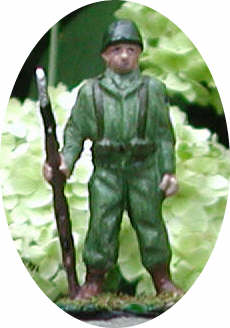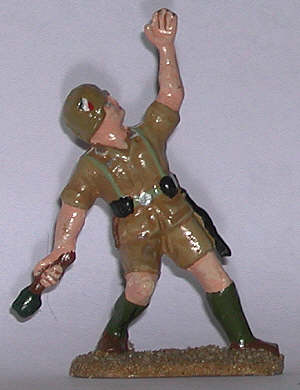
Copyright 2008 All Rights Reserved

What makes a good toy soldier?
What makes a great toy soldier?
There are many ingredients that go into making a good toy soldier. The first thing is proportion. It really helps a figure if the limbs, head and extraneous equipment are properly proportioned. Fat heads, shorty arms, spindly legs and the like make for poor figures.
Attention to detail helps. Having the right things in the right place makes a difference.
A big factor is the pose itself. A good pose is animated.. You do not have to guess what the soldier is doing. It is clear at first sight. Good animation can even be accomplished in a standing figure.
|
They are standing still, yet these two crudely-sculpted soldiers have a hint of imminent movement. Their animation is subtle. Do you think they have character? |
A simple pose that is fraught with animation. He is moving slowly, to be sure, but you get the feel of movement. The detail may be crude, but the overall pose is a good one |
A Revolutionary War rifleman in the act of firing. His pose is not liquidly fluid, nor is it rigidly stiff. There is just enough animation to make him interesting. |
The same can be said of any good toy soldier. Its pose tells you what it is doing. Everything else tells you what it is. A good toy soldier is easily identified by its army and its particular mission. You know right away the nationality, the era and the type of soldier he is.
|
Here is a Civil War soldier waving. He is probably using his fellow soldiers forward. His uniform, equipment and pose are all consistent with the Union Army of the American Civil War |
This is an American soldier charging with fixed bayonet. The cut of his uniform and his equipment Tell us he is American circa 1942 - 1950. The color tells us that he is a World War II soldier. Khaki Tan jackets were not used after 1945. |
This is a Bavarian soldier who is advancing. The color tells us he is a Bavarian German, not Prussian or Sachsen. Bavarian troops adopted the spiked helmet after 1871, so he is likely 1900 - 1910. The plain ammo pouches on his belt tell us that he is from 1910 or earlier. After 1910, German forces used a pair of three-pouch ammo cases. |
One thing is essential in making a great figure, and it cannot be measured or described in precise terms. That element is "character." You might also call it "personality." The figure may have fine details; or be crude. If it has character, it will stand out. I believe that character is imparted when the sculptor truly loves the subject of his work. Only a very human touch can infuse a figure with distinctive flair. "Character" is hard to define, but when you see it, you recognize it. Character is the difference that makes a great toy soldier.
|
This G.I. has a forlorn look. You can see personality in his face and posture. |

This German soldier has an animated pose, interesting detail and a feel of motion. He stands out because there is an individual quality to him. |
Toy Soldier Art thrives on two elements: well-sculpted figures and artful painting. The figures do not have to have exquisite detail. What they really need is animated posing and a touch of character. That is what makes it art. only an artist can impart character to an inanimate object.
Contact Us at thortrains@comcast.net